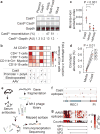A multifunctional AAV-CRISPR-Cas9 and its host response
- PMID: 27595405
- PMCID: PMC5374744
- DOI: 10.1038/nmeth.3993
A multifunctional AAV-CRISPR-Cas9 and its host response
Abstract
CRISPR-Cas9 delivery by adeno-associated virus (AAV) holds promise for gene therapy but faces critical barriers on account of its potential immunogenicity and limited payload capacity. Here, we demonstrate genome engineering in postnatal mice using AAV-split-Cas9, a multifunctional platform customizable for genome editing, transcriptional regulation, and other previously impracticable applications of AAV-CRISPR-Cas9. We identify crucial parameters that impact efficacy and clinical translation of our platform, including viral biodistribution, editing efficiencies in various organs, antigenicity, immunological reactions, and physiological outcomes. These results reveal that AAV-CRISPR-Cas9 evokes host responses with distinct cellular and molecular signatures, but unlike alternative delivery methods, does not induce extensive cellular damage in vivo. Our study provides a foundation for developing effective genome therapeutics.
Figures



References
Publication types
MeSH terms
Grants and funding
LinkOut - more resources
Full Text Sources
Other Literature Sources
Molecular Biology Databases
Research Materials

